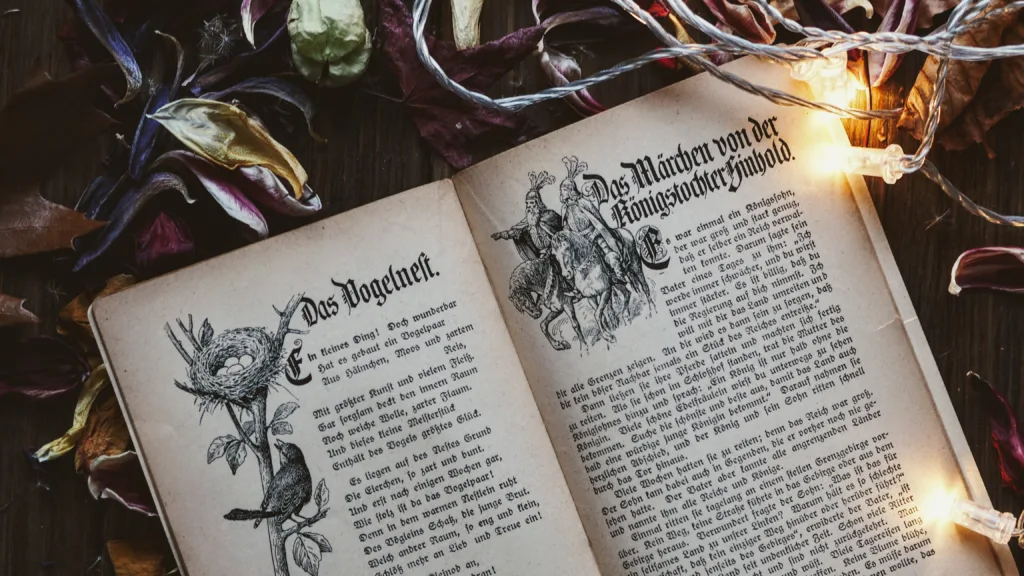Fairy tales have been around for centuries and are still loved by people of all ages today. These stories are oten filled with magic, adventure, and a moral lesson to be learned. In this blog post, we’ll explore the elements that make up a classic fairy tale.
The Opening
A fairy tale usually begins with the classic phrase, “Once upon a time.” This phrase sets the mood for the story and lets the reader know that they are about to enter a world of fantasy.
Defined Characters
Fairy tales often have clearly defined characters, with a virtuous protagonist and a malevolent antagonist. The protagonist is the hero of the story, while the antagonist is the villain who tries to thwart the protagonist’s plans.
Magic Settings
Fairy tales take place in magical settings such as enchanted forests, castles, or kingdoms. These settings help create the fantastical world that the story takes place in.
A Central Conflict
A fairy tale usually has a central conflict that the protagonist must overcome. This conflict can be anything from an evil sorcerer to a curse that needs to be broken.
A Moral Lesson
One of the most important elements of a fairy tale is the moral lesson that is taught. These lessons can be anything from the importance of kindness to the dangers of vanity. Fairy tales are a great way to teach children important values and life lessons.
Happy Endings
Fairy tales always have a happy ending. The protagonist overcomes the central conflict and is rewarded with a happy ending. This ending can be anything from a happily ever after to a reward for their bravery.
Fairy tales are a timeless genre that have been loved for centuries. They are filled with magic, adventure, and a moral lesson to be learned. The elements of a classic fairy tale include the opening, defined characters, magic settings, a central conflict, a moral lesson, and a happy ending. Whether you’re reading them to children or enjoying them yourself, fairy tales are a wonderful way to escape into a world of fantasy and imagination.
The Five Main Elements of a Fairy Tale
Fairy tales are stories that have been passed down from generation to generation and have become a beloved part of many cultures around the world. There are five main elements that are typically found in most fairy tales. These include the moral lesson, the characters, magic, obstacles or tasks, and the happily ever after ending.
The moral lesson is a key component of a fairy tale. It is a message or teaching that is meant to impart wisdom or guidance to the reader or listener. Often, the moral lesson is hidden within the story and requires the reader to reflect on the events and characters in order to decipher its meaning.
The characters in a fairy tale are typically archetypal and easily recognizable. These include the hero or heroine, the villain, and the supporting characters. Each character has a specific role to play in the story and helps to move the plot along.
Magic is a common element in fairy tales and often serves to create a sense of wonder and awe. This can include magical creatures, spells, and enchanted objects. Magic is often used to help the hero or heroine overcome obstacles or achieve ther goals.
Obstacles or tasks are another important element of a fairy tale. These are challenges that the hero or heroine must overcome in order to achieve their goals. These obstacles can take many forms, including physical challenges, emotional challenges, or challenges put in place by the villain.
Fairy tales typically end with a happily ever after ending. This is a resolution to the story that sees the hero or heroine achieve their goals and live happily ever after. This ending serves to provide a sense of closure and satisfaction to the reader or listener.

The Seven Elements of a Fairy Tale
A fairy tale is a type of story that typically involves magical creatures, enchantments, and a sense of wonder. There are seven key elements that are commonly found in fairy tales. The first element is the beginning and ending, which often start with “once upon a time” and end with “they lived happily ever after.” The second element is the concept of good and evil, with a virtuous protagonist and a malevolent antagonist. The third element is magic, which may include talking animals, magical food, special objects, and fairy godmothers. The fourth element is conflict, where the antagonist tris to thwart the protagonist. The fifth element is resolution, where the protagonist overcomes the antagonist and achieves their goal. The sixth element is the use of magic numbers, such as three or seven, which have special significance in the story. the seventh element is teaching morals, as fairy tales often provide lessons about values and behavior. Together, these seven elements create the magical world of fairy tales that continue to capture our imaginations today.
The Ten Elements of a Fairy Tale
Fairy tales are a type of folklore that often involve magical creatures or events and take place in a fictional world. While tere are different variations of fairy tales, they typically contain 10 common elements. The first element is the opening, which sets the stage for the story and usually begins with “once upon a time” or a similar phrase.
The second element is defined characters, which includes the protagonist, antagonist, and any secondary characters. These characters are often stereotypical and represent certain traits or values.
The third element is magic settings, which are unique and fantastical environments that are often enchanted or cursed. These settings can include forests, castles, and other mystical places.
The fourth element is a central conflict, which is the problem or challenge that the protagonist must overcome. This conflict can be external or internal and often involves a struggle between good and evil.
The fifth element is a moral lesson, which is the underlying message or theme of the story. This lesson can be explicit or implicit and is often related to the virtues of kindness, bravery, and perseverance.
The sixth element is happy endings, which are a common feature of fairy tales. These endings typically involve the protagonist overcoming the central conflict and achieving their goals.
The seventh element is repetition, which is a common technique used in fairy tales to reinforce the story’s themes and motifs. This can include repeated phrases, actions, or symbols.
The eighth element is numbers, which are often used symbolically in fairy tales. For example, the number three is commonly used to represent completion or unity.
The ninth element is symbolism, which is the use of objects, animals, or other elements to represent abstract ideas or concepts. This can include the use of a magic mirror to represent vanity or a poisoned apple to represent temptation.
The tenth and final element is cultural significance, which refers to the historical and cultural context in which the fairy tale was created. Many fairy tales have origins in ancient myths or legends and reflect the values and beliefs of the people who told them.
The Essential Element of Fairy Tales
Fairy tales are a genre of literature that are defined by several key elements, but perhaps the most defining element is their use of fantasy, supernatural, or make-believe aspects. These stories are often set in a world that is different from our own, with magical creatures, enchanted objects, and mystical powers that are not found in the real world. This element of fantasy allows readers to escape from reality and immerse themselves in a world of imagination and wonder. Additionally, fairy tales usually have clearly defined good characters versus evil characters, which adds to the dramatic tension of the story and helps to create a sense of moral clarity. the element of fantasy is what most defines a fairy tale and sets it aart from other genres of literature.
Characteristics of a Fairytale
Sure, I’d be happy to provide you with a detailed answer to your question. Fairy tales are a form of literature that have been enjoyed by people of all ages for centuries. There are several characteristics that are common to most fairy tales. Here are three of them:
1. Plot-driven with action and suspense: Fairy tales typically have a plot that is driven by action and suspense. There is often a protagonist who is faced with a problem or conflict that they must overcome in order to achieve their goal. Along the way, they face obstacles and challenges that create tension and keep the reader engaged.
2. Universal and relatable conflicts: The conflicts in fairy tales are often universal and relatable to real life. They deal with issues such as love, jealousy, greed, and power, which are all themes that are relevant to people of all cultures and backgrounds. These conflicts often teach valuable lessons aout morality and the consequences of one’s actions.
3. Happy endings: Fairy tales typically have happy endings, which is why they are sometimes referred to as having a “fairy tale ending”. The protagonist overcomes their challenges and achieves their goal, often finding true love or gaining wealth and power. These happy endings provide a sense of closure and satisfaction for the reader, leaving them with a positive message and a feeling of hope.

What Characteristics Define a Fairytale?
A fairy tale is a type of story that typically involves magical or fantastical elements, such as talking animals, enchanted objects, and supernatural beings like witches, fairies, or dragons. These stories often take place in a fictional, magical realm that is distinct from the real world, and they usualy focus on a hero or heroine who faces a series of challenges or obstacles. Typically, fairy tales involve themes of good versus evil, and the hero or heroine must overcome some sort of adversity, often with the help of magical or supernatural forces. Additionally, fairy tales often include moral lessons or messages, and they may explore universal themes like love, loyalty, and bravery. the defining characteristics of a fairy tale include magical elements, a distinct setting, a hero or heroine facing challenges, and a focus on exploring moral or universal themes.
The Nine Major Elements of a Story
Sure! A story is comprised of nine major elements that work together to create a powerful and engaging narrative. These elements are:
1. Main theme: This is the central idea or message that the story is trying to convey. It is the underlying concept that ties everything together.
2. Characters: Characters are the individuals who drive the story forward. They can be human or non-human, and they should be well-rounded and dynamic.
3. Setting: The setting is the time and place where the story takes place. It includes the physical environment, cultural and historical context, and social norms.
4. Tension: Tension is the conflict or problem that the characters face. It is what keeps the story interesting and makes readers want to keep reading.
5. Climax: The climax is the point of highest tension in the story. It is the moment when the conflict comes to a head and the outcome is decided.
6. Resolution: The resolution is the conclusion of the story. It is where the loose ends are tied up and the conflict is resolved.
7. Plot: The plot is the sequence of events that make up the story. It includes the exposition, rising action, climax, falling action, and resolution.
8. Purpose: The purpose of the story is the reason for its existence. It can be to entertain, educate, inspire, or persuade.
9. Chronology: Chronology is the order in which events occur in the story. It is important for the reader to understand the sequence of events to fully grasp the story.
By incorporating all of thse elements into your writing, you can create a compelling story that resonates with readers and leaves a lasting impact.
The Ten Elements of a Story
The 10 elements of a story are the essential components that make up a well-crafted narrative. These elements include plot, character, setting, theme, point of view, conflict, resolution, dialogue, pacing, and tone.
Plot refers to the sequence of events that make up the story, including the introduction, rising action, climax, falling action, and resolution. Character refers to the individuals or creatures that populate the story and drive the plot forward. Setting refers to the time and place in which the story takes place, including the physical environment and cultural context.
Theme refers to the underlying message or moral of the story, while point of view refers to the perspective from which the story is told. Conflict refers to the obstacles or challenges that the characters face thrughout the story, while resolution refers to the way in which those conflicts are resolved.
Dialogue refers to the conversations between characters, while pacing refers to the speed at which the story unfolds. Tone refers to the overall mood or atmosphere of the story, which can be serious, humorous, suspenseful, or any number of other emotions.
Together, these 10 elements work together to create a cohesive and engaging story that captures the reader’s attention and leaves a lasting impression.
The Eight Elements of Fairy Tales
Fairy tales are a popular genre of literature that have been passed down through generations. There are eight key elements that are commonly found in fairy tales.
The first element is the opening and ending line, which often begins with “Once upon a time” and ends with “happily ever after”. This sets the tone for a story that is perceived to have occurred in the past and often has a happy ending.
The second element is the presence of a hero or heroine and a villain. Fairy tales have clearly defined protagonists and antagonists, and often involve a battle between good and evil.
The third element is magic, which can manifest in various forms such as spells, curses, and enchanted objects. Magic is often integral to the plot and helps to create a sense of wonder and fantasy.
The fourth element is royalty, which is often featured in fairy tales. Princesses, princes, kings, and queens are common characters, and their roles are often central to the plot.
The fifth element is a problem or conflict that the hero or heroine must overcome. This may involve a task or quest that they must complete or a danger that they must face.
The sixth element is a solution to the problem or conflict. This may involve the use of magic, the assistance of other characters, or the hero or heroine’s own skills and abilities.
The seventh element is a universal lesson or moral that is conveyed through the story. This may involve themes such as the importance of perseverance, the dangers of greed, or the power of love.
There are learning resources such as books, films, and educational materials that can help children and adults to understand and appreciate the rich cultural heritage of fairy tales. By exploring the eight elements of fairy tales, we can gain a deeper understanding of this beloved literary genre.

Rules of a Fairytale
Fairy tales are stories that have been passed down throuh generations, and they often have a set of rules that define their structure. First and foremost, fairy tales usually begin with a phrase such as “once upon a time” or “long ago.” They take place in a distant, make-believe land and feature imaginary characters such as dragons, fairies, elves, and giants.
Fairy tales often follow a pattern of threes and sevens, such as three bears, three wishes, or seven brothers. This pattern helps to create a sense of balance and symmetry in the story. Additionally, fairy tales often have a moral or lesson that is taught through the characters and their experiences. This can be seen in classic tales like “The Tortoise and the Hare” and “Cinderella.”
Another common element of fairy tales is the use of magic. Magic often plays a key role in the plot, and it can be used to solve problems, create obstacles, or transform characters. This magical element adds to the fantastical atmosphere of the story and allows for unexpected twists and turns.
The rules of a fairy tale include a fantastical setting, imaginary characters, a pattern of threes and sevens, a moral or lesson, and the use of magic. These rules help to create a distinct structure and tone that is characteristic of this beloved genre.
Common Themes in Fairy Tales
Fairy tales are known for their enduring popularity and captivating storytelling. A common theme found in many fairy tales is the coming of age, where young protagonists must navigate the challenges of growing up and discovering their place in the world. Religion is anoter common theme, with many stories featuring religious motifs and symbols. Transformation is also a recurring theme, as characters often undergo a dramatic change, both physically and emotionally. Cunning and cleverness are celebrated in fairy tales, with many heroes and heroines outsmarting their opponents through wit and resourcefulness. Loyalty is another important theme, with characters often facing difficult choices and remaining true to their friends, family, or cause. Marriage is also a popular theme, with many stories culminating in a wedding or featuring a romantic subplot. Appearances can be deceiving in fairy tales, with characters often hiding their true selves or possessing magical abilities. justice and judgment are themes that appear in many fairy tales, with bad characters often receiving their just desserts and good characters being rewarded for their kindness and bravery.
Structuring a Fairy Tale
When it comes to structuring a fairy tale, there are some key elements that you should consider. First and foremost, you’ll want to have a clear moral or lesson that you want to convey through your story. This will help guide your plot and character development.
Next, you’ll want to create a hero who will face challenges and obstacles throughot the story. This hero should be relatable and likeable, so that your readers will root for them to succeed.
In addition to your hero, you’ll want to create a compelling villain. This could be an evil queen, a wicked witch, or some other nefarious character who seeks to thwart your hero’s progress.
One key element of any fairy tale is the magical element. This could be a fairy godmother, a magic potion, or some other fantastical element that helps move the story along.
The setting of your fairy tale is also important. You’ll want to create a world that feels immersive and believable, even if it’s filled with magical elements. This could be a medieval village, a enchanted forest, or some other fantastical location.
It’s important to write a happy ending for your fairy tale. This could mean that your hero defeats the villain, finds true love, or otherwise achieves their goals. Whatever the outcome, it should be satisfying and leave your readers feeling uplifted.
Number of Elements in Fairy Tail
In Fairy Tail, there are a total of seven elemental magic types. These are Fire, Ice, Holy, Demon, Light, Dark, and Non-Elemental. Each of these types has its own unique characteristics and strengths, and both characters and enemy monsters in the series can have different compatibilities with each of the elements. Understanding these elemental types and how they interact with each other is important for mastering magic and becoming a powerful mage in the world of Fairy Tail.

Conclusion
Fairy Tales are a genre of folklore that have endured throuhout the ages. They are known for their magical and fantastical elements, which often include talking animals, enchanted objects, and fairy godmothers. The characters in Fairy Tales are usually clearly defined as either good or evil, with a virtuous protagonist and a malevolent antagonist. These stories often involve obstacles or tasks that the protagonist must overcome in order to achieve their goal. Additionally, Fairy Tales are known for teaching moral lessons, which are usually conveyed through the actions of the characters. Despite the many variations that exist, Fairy Tales typically follow a similar structure, with a clear beginning, middle, and end. Fairy Tales continue to captivate audiences of all ages with their timeless themes of love, courage, and perseverance.
